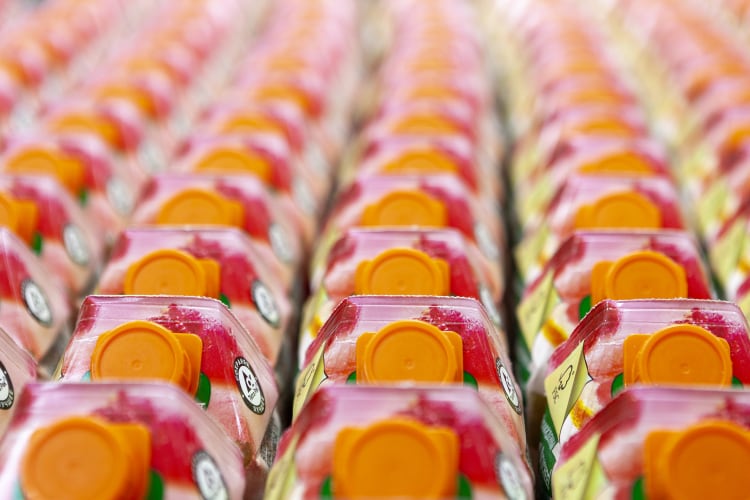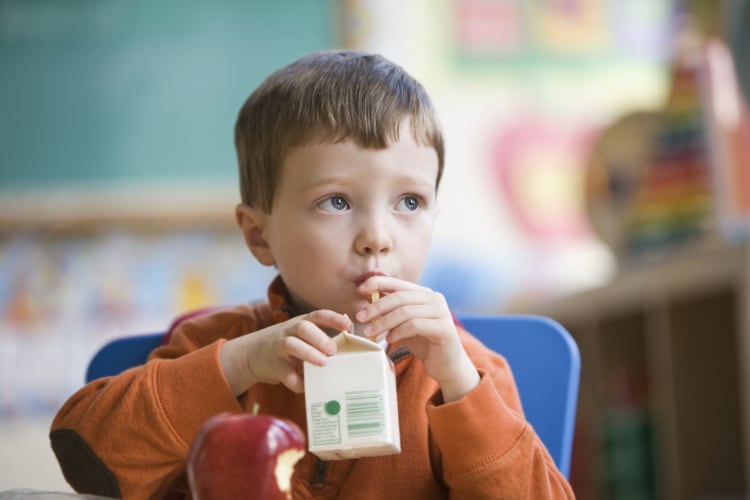Tetra Pak cartons are typically 70% paperboard, 25% plastic and 5% aluminium.
The aluminium layer plays an important role. It protects the food or beverage inside its cartons, keeping products safe and preventing spoilage by offering an impermeable metal barrier to light, UV rays, micro-organisms and other contaminants.
When used in food and drink packaging, aluminium is non-toxic, non-tainting and retains the product’s flavour. It is the lightest ‘complete barrier’ in common use and – as a material – aluminium is infinitely recyclable.
Despite all of these benefits, aluminium poses a bit of a challenge for Tetra Pak. While 5% of the total package might not sound a lot – the layer is after all thinner than a human hair – the aluminium alone contributes a whopping third of GHG emission linked to the base materials.
In a F&B industry where net zero and carbon neutral targets are increasingly core to business objectives, this outsized footprint is somewhat problematic for the packaging giant.
“We are keen to evolve and adapt, taking into account the rapidly changing scenarios and growing expectations from customers, society and regulators. Our aim is to develop the world’s most sustainable food package, a carton package that is fully made of responsibly sourced renewable materials, is fully recyclable and carbon neutral. Replacing the aluminium foil is one of several important actions to be able to realise this goal,” Davide Braghiroli, Product Director Packaging Materials and Alternative Barriers, told us.
‘Next level’ packaging targets new barrier materials
Tetra Pak is now moving to the ‘next level’ of development - testing a fibre-based barrier that it says is a first within food carton packages distributed under ambient conditions.

The company has just completed a 15-month process of commercial technology validation for a polymer-based barrier that could replace aluminium. The trial, which was conducted in Japan, helped Tetra Pak to understand the value chain implications of the change, and to quantify the carbon footprint reduction. It also confirmed adequate oxygen protection for vegetable juice, while enabling increased recycling rates in a country where recyclers favour aluminium-free cartons.
“The pilot batch of single serve packs featuring the fibre-based barrier that are currently on test represents a key marker in this exciting journey, goal being to develop future generations of alternative barriers in the coming years,” Braghiroli reflected.
Early results suggest ‘substantial’ CO2 reduction when compared to traditional aseptic cartons, while also delivering ‘comparable’ shelf life and food protection properties.
This initiative underscores Tetra Pak’s approach to design for recycling. “It increases the attractiveness of post-consumer carton packages for paper mills, because of the higher paper content,” the materials expert elaborated. “Recycling tests done on packaging material including the fibre-based barrier showed properties of the recycled Polyethylene closer to other recycled Polyethylene without aluminium in the recycling input.”
Sustainability as competitive advantage
The concept carton has a fibre-based barrier that is composed of 'paper and barriers', FoodNavigator understands. But what are these made of? Braghiroli was rather tight-lipped about any further details. “We are working closely with existing and new suppliers to source this material… Further details cannot be shared at this point due to confidentiality reasons.”
It is hardly surprising that Tetra Pak doesn’t want to give too much away on the science and technology behind its latest packaging innovation. The company is investing €100 million for the next 5-10 years to ‘further enhance the environmental profile of food cartons’. This includes the research and development of packages that are made with a ‘simplified material structure and increased renewable content’, we were told.
This R&D is key to unlocking what is becoming an ever more significant market opportunity: meeting growing consumer and customer demand for sustainable packaging.

“When it comes to the food and beverage industry, we know from our 2021 Environmental B2B research that climate change and wasteful package are key concerns for manufacturers and retailers; and that adapting to consumer needs and securing sustainability in the business are the top two priorities for them,” Braghiroli told us.
On top of this, Tetra Pak’s 2021 Sustainable Packaging consumer research revealed around 40% of shoppers said ‘if packages were made entirely from paperboard and had no plastic or aluminium’ this would motivate them to sort for recycling even more.
“We believe that, by choosing the carton with a fibre-based barrier, F&B companies can meet consumers’ expectations, while also reducing their carbon footprint.”
What’s next for this industry first?
Incorporating these learnings, Tetra Pak has started testing this new fibre-based barrier in ‘close collaboration’ with some of its customers.
A first pilot batch of single serve packs featuring this 'industry-first' material are currently on shelf – in an unidentified market outside of Japan - for a commercial consumer test. Further technology validation is scheduled later in 2022, the company revealed, declining to provide further information on the trial.
“Once concluded the testing phase to verify the technical maturity, and collected the relevant learnings, we’ll start the product development journey and offer the solution to other customers.”

